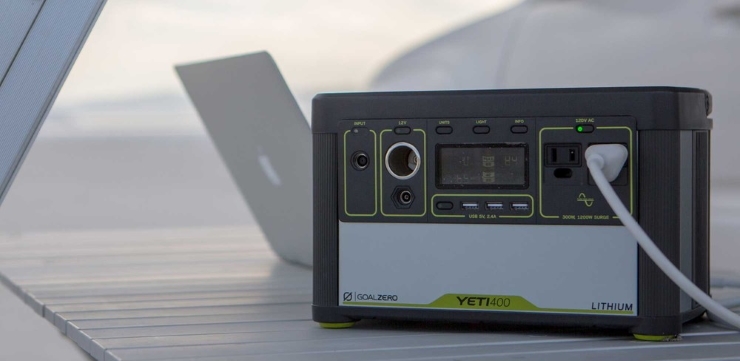How Long Will a Solar Generator Last For?
Page Contents
Written by qualified solar engineer Aniket. Last updated:
Solar generators last anywhere between a few hundred to a few thousand charging cycles. The most critical component that decides the life span of the solar generator is its battery. Hence, the life span is also dependent on the type of battery – lithium-based batteries generally have more lifecycles than lead-acid batteries. Thus, it is obvious that generators charged and discharged more regularly will have a shorter lifespan.
Another factor that affects the life of the generator is how you use the device. There is a sweet spot in terms of the percentage of charging and discharging – this is somewhere around 80%. Ultimately, different brands specify different battery lifecycles, and you must choose what fits your overall requirements and budget the best.
Understanding Generator Lifespan

Solar energy has rapidly taken over fossil fuel energy in recent years. From large scale solar power plants to portable solar powered generators, the change is visible on all levels. The benefit of a solar generator system over traditional diesel generators is multifold. It reduces carbon emissions while also providing freedom from recurring fuel expenses.
The life span of a solar generator system depends on a few factors, notably its ruggedness, quality of individual components, and the specified lifespan of these components. An efficient solar generator is built using dozens of components, each of which constitutes in its own way to the life span of a solar generator. Let us have a look at some of the important factors:
Solar Panels
Some generators come with integrated solar panels, and for others, you need to purchase and connect them separately. Solar panels are robust devices guaranteed to last over 25 years. Thanks to no moving parts, there is no physical degradation of solar panels, nor does this emission-free power source require any maintenance besides cleaning.
Wiring and Electronics
There are several types of solar generators with varying features, but fundamentally, each consists of a few major constituents and several wires soldered to different components. This includes the Printed Circuit Board (PCB), a direct current to alternating current converter (inverter), rectifier, etc. As long as any of these components are not subject to physical stress, they are known to last quite a long time, often over ten years.
Even if your device is unfortunate enough to have taken a fall resulting in some internal electronic damage, it would not be difficult to disassemble the unit and repair the electronics inside. This may include re-soldering of wires or replacing other smaller internal parts.
Battery

The solar generator battery takes up most of its volume and weight. As batteries are chemical devices, they have a limited life, even with careful physical handling. The ideal solar generator battery should have both a high capacity and a long life.
Battery lifespan is usually measured in the number of cycles. One cycle is the complete charging and discharging of the battery. Different types of batteries may have different life spans. For example, lithium-based batteries, such as lithium-ion phosphate, have longer life cycles than traditional, lead-acid batteries.
The following are the lifespans of some popular solar backup generators.
Goal Zero Power Stations
One of the well-known makers of solar energy generators, Goal Zero offers several different options. This includes models that have lead-acid batteries in them, such as the Yeti 400, and models with lithium-based batteries, like the Yeti 1400 Lithium.
For its devices with lead-acid batteries, Goal Zero claims a lifespan of ‘hundreds of cycles’. Although that is not highly specific, these models are known to easily provide over 500 battery cycles. Similarly, the brand specifies that the generator can provide 500 cycles to 80% capacity for its lithium-based models. This means even after 500 cycles, the solar generator can run with 80% of its original battery life.
Renogy Solar Generators
Renogy is another brand that makes reliable solar backup generators. Its products use batteries that can serve significantly high lifecycles. For example, the Renogy Lycan Powerbox comes with a lithium-ion phosphate battery that boasts 2000 cycles before dropping to 80% capacity.
This would mean you could charge and discharge the battery many times it deteriorates. The brand also specifies a battery life of 5-7 years. Coupled with the number of lifecycles, this means that Renogy generators are designed to serve you for a significantly longer duration.
Most other popular solar backup generators have a similar battery lifespan – around a few hundred cycles mark; for example, the Jackery Explorer generator can run at least 500 cycles to 80%.
Getting the Most Out of Your Solar Energy Generator

Solar generators have come a long way in terms of capability. A powerful solar generator has enough power output to run several devices and appliances such as a TV, fridge, and some hand-tools, along with mobile phones and laptops. They are easy to carry and are a great solution to power outages.
Although not super-expensive, you would still not call a solar generator kit particularly cheap. This makes it important to take good care of the device so that it lasts long and serves you well.
This includes, first and foremost, handling the device with care. Most portable backup generators are designed to withstand some shocks but keep it to a minimum to make your generator work longer.
Unlike a fuel powered generator, a solar generator stores renewable energy from the sunlight in chemical form, hence needing a battery. Batteries are complex devices and last a few years, after which they must be replaced – a disadvantage of solar energy.
The life of a battery can be maximized by following a few simple practices, one of which is not leaving the battery discharged for a prolonged period. This may reduce the overall capacity and the total running hours.
Another good practice is not charging or discharging the battery by very small amounts, say by 20-30% at a time. You should also not charge the battery beyond 100%, which may severely reduce its power capacity. Charging and discharging around 80% is known to work best. Make sure to disconnect the solar panels or the wall plug once the device is fully charged.
When charging with solar, you should also make sure that the input voltage or current is not greater than specified. This is why most generator companies offer their solar panels designed to feed certain watts of continuous power at the specified voltage, mostly 12V, and current.
It also helps to understand how the solar generator works, whether you just want to take better care of your generator or you are thinking of sizing a solar generator on your own, based on your specific power consumption.
We hope you liked this article. Please rate it or leave us a comment.
Average rating 3.2 / 5. Vote count: 9
No votes so far! Be the first to rate this post.





